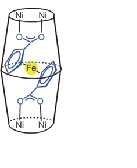Chemistry Journal of Moldova
DINUCLEAR COMPLEXES AS BUILDING BLOCKS FOR TETRA-NUCLEAR MACROCYCLIC COMPLEXES WITH DITHIOLATE MACROCYCLIC LIGAND
Author(s):
Field: Inorganic and coordination chemistry
Type: Research paper
Issue: 2013 Volume 8, no.1
Pages: 58-77
V. Lozan
Field: Inorganic and coordination chemistry
Type: Research paper
Issue: 2013 Volume 8, no.1
Pages: 58-77
coordination chemistry, amino-thiophenolate ligands, di- and tetranuclear complexes, ferrocene and naphthalene diimide derivatives, polynuclear complexes.
Full Text (PDF): Download
DOI: dx.doi.org/10.19261/cjm.2013.08(1).08
Graphical Abstract: A series of novel tri-, tetra- and pentanuclear complexes composed of dinuclear LM units (M=Co, Ni, Zn; L=24-membered macrocyclic hexaaza-dithiophenolate ligand) and ferrocenecarboxylate ([CpFeC5H4CO2]ˉ), 1,1’-ferrocenedicarboxy-late ([Fe(C5H4-CO2)2]2ˉ), acetylene-dicarboxylate, terephthalate, isophthalate, and naphthalene diimide dicarboxylate groups is reported. The complexes, have been synthesized and characterised by UV/Vis-, IR-, NMR-spectroscopy, Cyclovoltammetry, and X-ray crystallography. Each dicarboxylate dianion acts as a quadridentate bridging ligand linking two bioctahedral LM2 units via µ1,3-bridging carboxylate functions to generate discrete dications with a central LM2(O2C-R-CO2)M2L core. The magnetic properties of these compounds reveal the presence of weak ferromagnetic exchange interactions between the NiII ions of the dinuclear subunits and negligible coupling across the dicarboxylate bridges.

Downloads: 37






